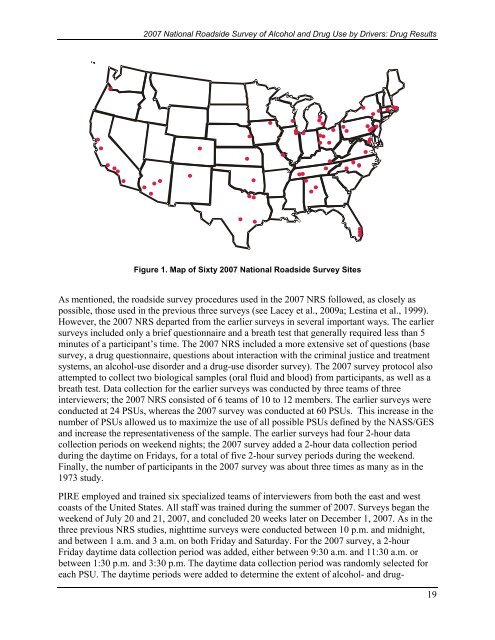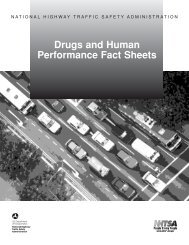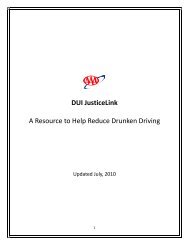2007 National Roadside Survey of Alcohol and Drug Use by Drivers
2007 National Roadside Survey of Alcohol and Drug Use by Drivers
2007 National Roadside Survey of Alcohol and Drug Use by Drivers
You also want an ePaper? Increase the reach of your titles
YUMPU automatically turns print PDFs into web optimized ePapers that Google loves.
<strong>2007</strong> <strong>National</strong> <strong>Roadside</strong> <strong>Survey</strong> <strong>of</strong> <strong>Alcohol</strong> <strong>and</strong> <strong>Drug</strong> <strong>Use</strong> <strong>by</strong> <strong>Drivers</strong>: <strong>Drug</strong> ResultsFigure 1. Map <strong>of</strong> Sixty <strong>2007</strong> <strong>National</strong> <strong>Roadside</strong> <strong>Survey</strong> SitesAs mentioned, the roadside survey procedures used in the <strong>2007</strong> NRS followed, as closely aspossible, those used in the previous three surveys (see Lacey et al., 2009a; Lestina et al., 1999).However, the <strong>2007</strong> NRS departed from the earlier surveys in several important ways. The earliersurveys included only a brief questionnaire <strong>and</strong> a breath test that generally required less than 5minutes <strong>of</strong> a participant’s time. The <strong>2007</strong> NRS included a more extensive set <strong>of</strong> questions (basesurvey, a drug questionnaire, questions about interaction with the criminal justice <strong>and</strong> treatmentsystems, an alcohol-use disorder <strong>and</strong> a drug-use disorder survey). The <strong>2007</strong> survey protocol alsoattempted to collect two biological samples (oral fluid <strong>and</strong> blood) from participants, as well as abreath test. Data collection for the earlier surveys was conducted <strong>by</strong> three teams <strong>of</strong> threeinterviewers; the <strong>2007</strong> NRS consisted <strong>of</strong> 6 teams <strong>of</strong> 10 to 12 members. The earlier surveys wereconducted at 24 PSUs, whereas the <strong>2007</strong> survey was conducted at 60 PSUs. This increase in thenumber <strong>of</strong> PSUs allowed us to maximize the use <strong>of</strong> all possible PSUs defined <strong>by</strong> the NASS/GES<strong>and</strong> increase the representativeness <strong>of</strong> the sample. The earlier surveys had four 2-hour datacollection periods on weekend nights; the <strong>2007</strong> survey added a 2-hour data collection periodduring the daytime on Fridays, for a total <strong>of</strong> five 2-hour survey periods during the weekend.Finally, the number <strong>of</strong> participants in the <strong>2007</strong> survey was about three times as many as in the1973 study.PIRE employed <strong>and</strong> trained six specialized teams <strong>of</strong> interviewers from both the east <strong>and</strong> westcoasts <strong>of</strong> the United States. All staff was trained during the summer <strong>of</strong> <strong>2007</strong>. <strong>Survey</strong>s began theweekend <strong>of</strong> July 20 <strong>and</strong> 21, <strong>2007</strong>, <strong>and</strong> concluded 20 weeks later on December 1, <strong>2007</strong>. As in thethree previous NRS studies, nighttime surveys were conducted between 10 p.m. <strong>and</strong> midnight,<strong>and</strong> between 1 a.m. <strong>and</strong> 3 a.m. on both Friday <strong>and</strong> Saturday. For the <strong>2007</strong> survey, a 2-hourFriday daytime data collection period was added, either between 9:30 a.m. <strong>and</strong> 11:30 a.m. orbetween 1:30 p.m. <strong>and</strong> 3:30 p.m. The daytime data collection period was r<strong>and</strong>omly selected foreach PSU. The daytime periods were added to determine the extent <strong>of</strong> alcohol- <strong>and</strong> drug-19




